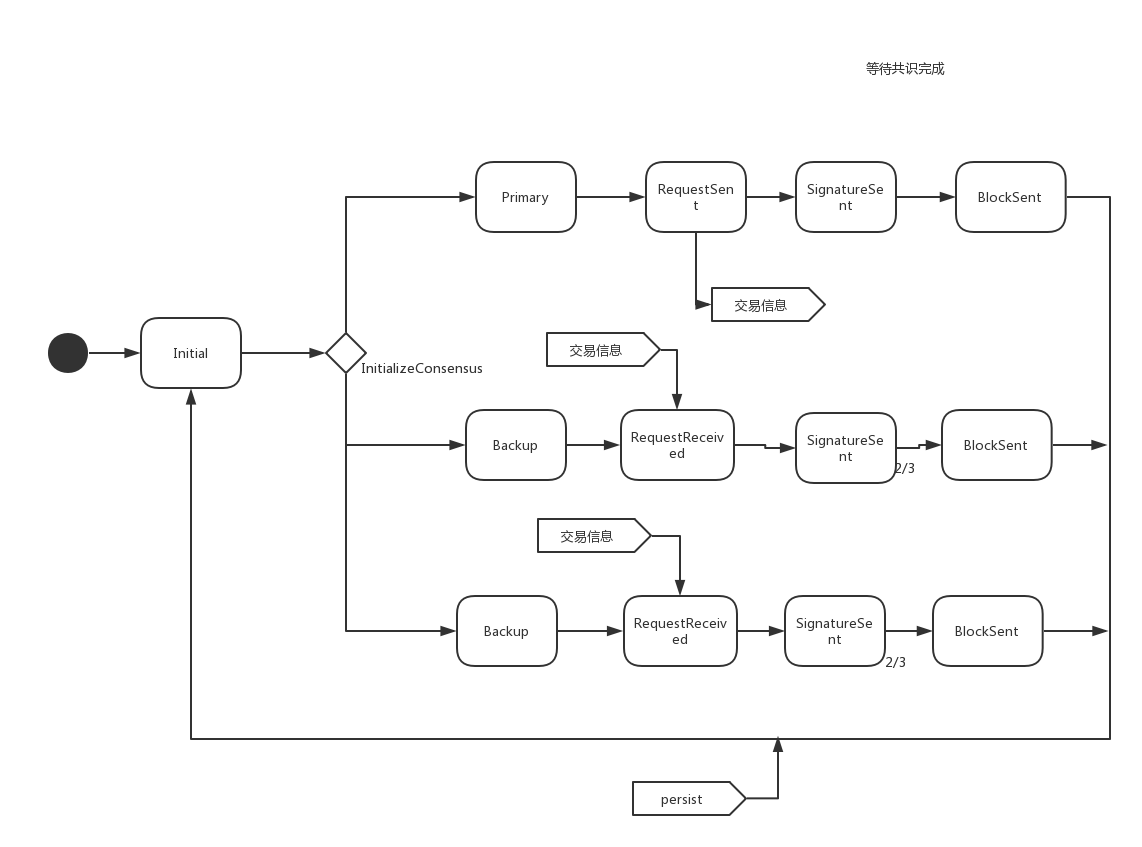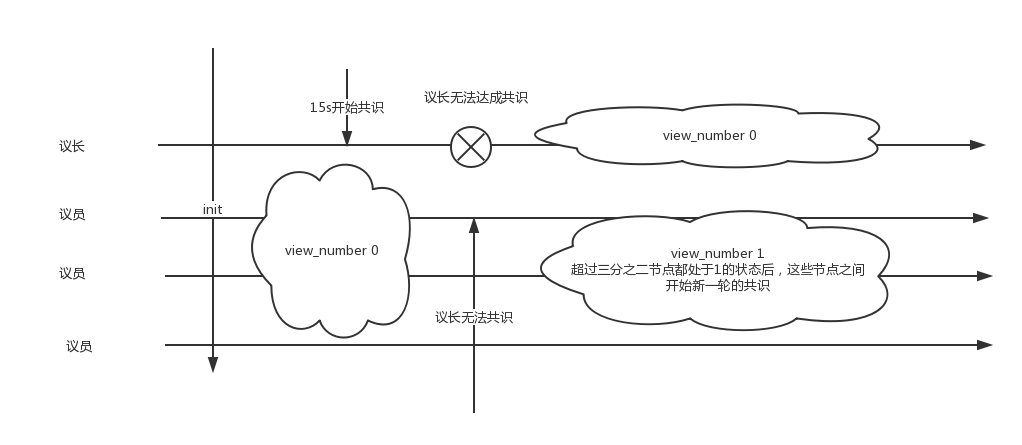жӮЁеҘҪпјҢзҷ»еҪ•еҗҺжүҚиғҪдёӢи®ўеҚ•е“ҰпјҒ
жӮЁеҘҪпјҢзҷ»еҪ•еҗҺжүҚиғҪдёӢи®ўеҚ•е“ҰпјҒ
иҝҷзҜҮж–Үз« дё»иҰҒд»Ӣз»ҚвҖңNEO DBFTе…ұиҜҶз®—жі•жәҗз ҒеҲҶжһҗвҖқзҡ„зӣёе…ізҹҘиҜҶпјҢе°Ҹзј–йҖҡиҝҮе®һйҷ…жЎҲдҫӢеҗ‘еӨ§е®¶еұ•зӨәж“ҚдҪңиҝҮзЁӢпјҢж“ҚдҪңж–№жі•з®ҖеҚ•еҝ«жҚ·пјҢе®һз”ЁжҖ§ејәпјҢеёҢжңӣиҝҷзҜҮвҖңNEO DBFTе…ұиҜҶз®—жі•жәҗз ҒеҲҶжһҗвҖқж–Үз« иғҪеё®еҠ©еӨ§е®¶и§ЈеҶій—®йўҳгҖӮ
dbftж”№иҝӣиҮӘз®—жі•pbftз®—жі•пјҢpbftз®—жі•йҖҡиҝҮеӨҡж¬ЎзҪ‘з»ңиҜ·жұӮзЎ®и®ӨпјҢжңҖз»ҲиҺ·еҫ—еӨҡж•°е…ұиҜҶгҖӮе…¶зјәзӮ№еңЁдәҺйҡҸзқҖйҡҸзқҖиҠӮзӮ№зҡ„еўһеҠ пјҢзҪ‘з»ңејҖй”Җе‘ҲжҢҮж•°зә§еўһй•ҝпјҢзҪ‘з»ңйҖҡдҝЎиҶЁиғҖпјҢйҡҫд»Ҙеҝ«йҖҹиҫҫжҲҗдёҖиҮҙгҖӮneoзҡ„и§ЈеҶіж–№жЎҲжҳҜйҖҡиҝҮжҠ•зҘЁйҖүеҸ–еҮәдёҖе®ҡж•°йҮҸзҡ„иҠӮзӮ№дҪңдёәи®°иҙҰдәәпјҢз”ұжӯӨеҮҸе°‘зҪ‘з»ңж¶ҲиҖ—еҸҲеҸҜд»Ҙе…јйЎҫдәӨжҳ“йҖҹеәҰпјҢиҝҷд№ҹжҳҜdbftдёӯdзҡ„з”ұжқҘгҖӮ
в”ңв”Җв”Җ Consensus в”Ӯ в”ңв”Җв”Җ ChangeView.cs //viewchange ж¶ҲжҒҜ в”Ӯ в”ңв”Җв”Җ ConsensusContext.cs //е…ұиҜҶдёҠдёӢж–Ү в”Ӯ в”ңв”Җв”Җ ConsensusMessage.cs //е…ұиҜҶж¶ҲжҒҜ в”Ӯ в”ңв”Җв”Җ ConsensusMessageType.cs //е…ұиҜҶж¶ҲжҒҜзұ»еһӢ ChangeView/PrepareRequest/PrepareResponse в”Ӯ в”ңв”Җв”Җ ConsensusService.cs //е…ұиҜҶж ёеҝғд»Јз Ғ в”Ӯ в”ңв”Җв”Җ ConsensusState.cs //иҠӮзӮ№е…ұиҜҶзҠ¶жҖҒ в”Ӯ в”ңв”Җв”Җ PrepareRequest.cs //иҜ·жұӮж¶ҲжҒҜ в”Ӯ в””в”Җв”Җ PrepareResponse.cs //зӯҫеҗҚиҝ”еӣһж¶ҲжҒҜ
1:ејҖеҗҜе…ұиҜҶзҡ„иҠӮзӮ№еҲҶдёәдёӨеӨ§зұ»пјҢйқһи®°иҙҰдәәе’Ңи®°иҙҰдәәиҠӮзӮ№пјҢйқһи®°иҙҰдәәзҡ„дёҚеҸӮдёҺе…ұиҜҶпјҢи®°иҙҰдәәеҸӮдёҺе…ұиҜҶжөҒзЁӢ
2:йҖүжӢ©и®®й•ҝпјҢNeoи®®й•ҝдә§з”ҹжңәеҲ¶жҳҜж №жҚ®еҪ“еүҚеқ—й«ҳеәҰе’Ңи®°иҙҰдәәж•°йҮҸеҒҡMODиҝҗз®—еҫ—еҲ°пјҢи®®й•ҝе®һйҷ…дёҠжҢүйЎәеәҸеҪ“йҖү
3:иҠӮзӮ№еҲқе§ӢеҢ–пјҢи®®й•ҝдёәprimaryиҠӮзӮ№пјҢи®®е‘ҳдёәbackupиҠӮзӮ№гҖӮ
4:ж»Ўи¶іеҮәеқ—жқЎд»¶еҗҺи®®й•ҝеҸ‘йҖҒPrepareRequest
5:и®®е‘ҳ收еҲ°иҜ·жұӮеҗҺпјҢйӘҢиҜҒйҖҡиҝҮзӯҫеҗҚеҸ‘йҖҒPrepareResponse
6:и®°иҙҰиҠӮзӮ№жҺҘ收еҲ°PrepareResponseеҗҺпјҢиҠӮзӮ№дҝқеӯҳеҜ№ж–№зҡ„зӯҫеҗҚдҝЎжҒҜпјҢжЈҖжҹҘеҰӮжһңи¶…иҝҮдёүеҲҶд№ӢдәҢеҲҷеҸ‘йҖҒ block
7:иҠӮзӮ№жҺҘ收еҲ°blockпјҢPersistCompletedдәӢ件и§ҰеҸ‘еҗҺж•ҙдҪ“йҮҚж–°еҲқе§ӢеҢ–пјҢ

public const uint Version = 0; public ConsensusState State; //иҠӮзӮ№еҪ“еүҚе…ұиҜҶзҠ¶жҖҒ public UInt256 PrevHash; public uint BlockIndex; //еқ—й«ҳеәҰ public byte ViewNumber; //иҜ•еӣҫзҠ¶жҖҒ public ECPoint[] Validators; //и®°иҙҰдәә public int MyIndex; //еҪ“еүҚи®°иҙҰдәәж¬ЎеәҸ public uint PrimaryIndex; //еҪ“еүҚи®°иҙҰзҡ„и®°иҙҰдәә public uint Timestamp; public ulong Nonce; public UInt160 NextConsensus; //е…ұиҜҶж ҮиҜҶ public UInt256[] TransactionHashes; public Dictionary<UInt256, Transaction> Transactions; public byte[][] Signatures; //и®°иҙҰдәәзӯҫеҗҚ public byte[] ExpectedView; //и®°иҙҰдәәиҜ•еӣҫ public KeyPair KeyPair; public int M => Validators.Length - (Validators.Length - 1) / 3; //дёүеҲҶд№ӢдәҢж•°йҮҸ
ExpectedView з»ҙжҠӨи§ҶеӣҫзҠ¶жҖҒдёӯпјҢз”ЁдәҺеңЁи®®й•ҝж— жі•жӯЈеёёе·ҘдҪңж—¶йҮҚж–°еҸ‘иө·ж–°дёҖиҪ®е…ұиҜҶгҖӮ
Signatures з”ЁдәҺз»ҙжҠӨе…ұиҜҶиҝҮзЁӢдёӯзҡ„зЎ®и®ӨзҠ¶жҖҒгҖӮ
[Flags]
internal enum ConsensusState : byte
{
Initial = 0x00, // 0
Primary = 0x01, // 1
Backup = 0x02, // 10
RequestSent = 0x04, // 100
RequestReceived = 0x08, // 1000
SignatureSent = 0x10, // 10000
BlockSent = 0x20, // 100000
ViewChanging = 0x40, //1000000
}neoзҡ„dbftз®—жі•зҡ„delegateйғЁеҲҶдё»иҰҒдҪ“зҺ°еңЁдёҖдёӘеҮҪж•°дёҠйқў,жҜҸж¬Ўдә§з”ҹеҢәеқ—еҗҺдјҡйҮҚж–°жҺ’еәҸиө„дә§пјҢйҖүжӢ©еүҚи®°иҙҰдәәж•°йҮҸзҡ„иҠӮзӮ№еҮәжқҘеҸӮдёҺдёӢдёҖиҪ®е…ұиҜҶгҖӮ
/// <summary>
/// иҺ·еҸ–дёӢдёҖдёӘеҢәеқ—зҡ„и®°иҙҰдәәеҲ—иЎЁ
/// </summary>
/// <returns>иҝ”еӣһдёҖз»„е…¬й’ҘпјҢиЎЁзӨәдёӢдёҖдёӘеҢәеқ—зҡ„и®°иҙҰдәәеҲ—иЎЁ</returns>
public ECPoint[] GetValidators()
{
lock (_validators)
{
if (_validators.Count == 0)
{
_validators.AddRange(GetValidators(Enumerable.Empty<Transaction>()));
}
return _validators.ToArray();
}
}
public virtual IEnumerable<ECPoint> GetValidators(IEnumerable<Transaction> others)
{
DataCache<UInt160, AccountState> accounts = GetStates<UInt160, AccountState>();
DataCache<ECPoint, ValidatorState> validators = GetStates<ECPoint, ValidatorState>();
MetaDataCache<ValidatorsCountState> validators_count = GetMetaData<ValidatorsCountState>();
///жӣҙж–°иҙҰеҸ·иө„дә§жғ…еҶө
foreach (Transaction tx in others)
{
foreach (TransactionOutput output in tx.Outputs)
{
AccountState account = accounts.GetAndChange(output.ScriptHash, () => new AccountState(output.ScriptHash));
if (account.Balances.ContainsKey(output.AssetId))
account.Balances[output.AssetId] += output.Value;
else
account.Balances[output.AssetId] = output.Value;
if (output.AssetId.Equals(GoverningToken.Hash) && account.Votes.Length > 0)
{
foreach (ECPoint pubkey in account.Votes)
validators.GetAndChange(pubkey, () => new ValidatorState(pubkey)).Votes += output.Value;
validators_count.GetAndChange().Votes[account.Votes.Length - 1] += output.Value;
}
}
foreach (var group in tx.Inputs.GroupBy(p => p.PrevHash))
{
Transaction tx_prev = GetTransaction(group.Key, out int height);
foreach (CoinReference input in group)
{
TransactionOutput out_prev = tx_prev.Outputs[input.PrevIndex];
AccountState account = accounts.GetAndChange(out_prev.ScriptHash);
if (out_prev.AssetId.Equals(GoverningToken.Hash))
{
if (account.Votes.Length > 0)
{
foreach (ECPoint pubkey in account.Votes)
{
ValidatorState validator = validators.GetAndChange(pubkey);
validator.Votes -= out_prev.Value;
if (!validator.Registered && validator.Votes.Equals(Fixed8.Zero))
validators.Delete(pubkey);
}
validators_count.GetAndChange().Votes[account.Votes.Length - 1] -= out_prev.Value;
}
}
account.Balances[out_prev.AssetId] -= out_prev.Value;
}
}
switch (tx)
{
#pragma warning disable CS0612
case EnrollmentTransaction tx_enrollment:
validators.GetAndChange(tx_enrollment.PublicKey, () => new ValidatorState(tx_enrollment.PublicKey)).Registered = true;
break;
#pragma warning restore CS0612
case StateTransaction tx_state:
foreach (StateDescriptor descriptor in tx_state.Descriptors)
switch (descriptor.Type)
{
case StateType.Account:
ProcessAccountStateDescriptor(descriptor, accounts, validators, validators_count);
break;
case StateType.Validator:
ProcessValidatorStateDescriptor(descriptor, validators);
break;
}
break;
}
}
//жҺ’еәҸ
int count = (int)validators_count.Get().Votes.Select((p, i) => new
{
Count = i,
Votes = p
}).Where(p => p.Votes > Fixed8.Zero).ToArray().WeightedFilter(0.25, 0.75, p => p.Votes.GetData(), (p, w) => new
{
p.Count,
Weight = w
}).WeightedAverage(p => p.Count, p => p.Weight);
count = Math.Max(count, StandbyValidators.Length);
HashSet<ECPoint> sv = new HashSet<ECPoint>(StandbyValidators);
ECPoint[] pubkeys = validators.Find().Select(p => p.Value).Where(p => (p.Registered && p.Votes > Fixed8.Zero) || sv.Contains(p.PublicKey)).OrderByDescending(p => p.Votes).ThenBy(p => p.PublicKey).Select(p => p.PublicKey).Take(count).ToArray();
IEnumerable<ECPoint> result;
if (pubkeys.Length == count)
{
result = pubkeys;
}
else
{
HashSet<ECPoint> hashSet = new HashSet<ECPoint>(pubkeys);
for (int i = 0; i < StandbyValidators.Length && hashSet.Count < count; i++)
hashSet.Add(StandbyValidators[i]);
result = hashSet;
}
return result.OrderBy(p => p);
}еңЁеҲқе§ӢеҢ–е…ұиҜҶзҠ¶жҖҒзҡ„ж—¶еҖҷдјҡи®ҫзҪ®PrimaryIndexпјҢиҺ·зҹҘеҪ“еүҚи®®й•ҝгҖӮеҺҹзҗҶе°ұжҳҜз®ҖеҚ•зҡ„MODиҝҗз®—гҖӮ иҝҷйҮҢжңүеҲҶдёәдёӨз§Қжғ…еҶөпјҢеҰӮжһңиҠӮзӮ№жӯЈеёёеҲҷзӣҙжҺҘеқ—й«ҳеәҰе’Ңи®°иҙҰдәәж•°йҮҸmodиҝҗз®—еҚіеҸҜпјҢеҰӮжһңеӯҳеңЁдёҖеңәжғ…еҶөпјҢеҲҷйңҖиҰҒж №жҚ®view_numberиҝӣиЎҢи°ғж•ҙгҖӮ
//file /Consensus/ConsensusService.cs InitializeConsensusж–№жі• if (view_number == 0) context.Reset(wallet); else context.ChangeView(view_number);
//file /Consensus/ConsensusContext.cs
public void ChangeView(byte view_number)
{
int p = ((int)BlockIndex - view_number) % Validators.Length;
State &= ConsensusState.SignatureSent;
ViewNumber = view_number;
PrimaryIndex = p >= 0 ? (uint)p : (uint)(p + Validators.Length);//еҪ“еүҚи®°иҙҰдәә
if (State == ConsensusState.Initial)
{
TransactionHashes = null;
Signatures = new byte[Validators.Length][];
}
ExpectedView[MyIndex] = view_number;
_header = null;
} //file /Consensus/ConsensusContext.cs
public void Reset(Wallet wallet)
{
State = ConsensusState.Initial;
PrevHash = Blockchain.Default.CurrentBlockHash;
BlockIndex = Blockchain.Default.Height + 1;
ViewNumber = 0;
Validators = Blockchain.Default.GetValidators();
MyIndex = -1;
PrimaryIndex = BlockIndex % (uint)Validators.Length; //еҪ“еүҚи®°иҙҰдәә
TransactionHashes = null;
Signatures = new byte[Validators.Length][];
ExpectedView = new byte[Validators.Length];
KeyPair = null;
for (int i = 0; i < Validators.Length; i++)
{
WalletAccount account = wallet.GetAccount(Validators[i]);
if (account?.HasKey == true)
{
MyIndex = i;
KeyPair = account.GetKey();
break;
}
}
_header = null;
}еҰӮжһңжҳҜи®®й•ҝеҲҷзҠ¶жҖҒж Үи®°дёәConsensusState.PrimaryпјҢеҗҢж—¶ж”№еҸҳе®ҡж—¶еҷЁи§ҰеҸ‘дәӢ件пјҢеҶҚдёҠж¬ЎеҮәеқ—15sеҗҺи§ҰеҸ‘гҖӮи®®е‘ҳеҲҷи®ҫзҪ®зҠ¶жҖҒдёә ConsensusState.BackupпјҢж—¶й—ҙи°ғж•ҙдёә30sеҗҺи§ҰеҸ‘пјҢеҰӮжһңи®®й•ҝдёҚиғҪжӯЈеёёе·ҘдҪңпјҢеҲҷиҝҷдёӘи§ҰеҸ‘еҷЁдјҡејҖе§Ӣиө·дҪңз”ЁпјҲе…·дҪ“еҗҺиҫ№еҶҚиҜҰз»ҶеҲҶжһҗпјүгҖӮ
//file /Consensus/ConsensusContext.cs
private void InitializeConsensus(byte view_number)
{
lock (context)
{
if (view_number == 0)
context.Reset(wallet);
else
context.ChangeView(view_number);
if (context.MyIndex < 0) return;
Log($"initialize: height={context.BlockIndex} view={view_number} index={context.MyIndex} role={(context.MyIndex == context.PrimaryIndex ? ConsensusState.Primary : ConsensusState.Backup)}");
if (context.MyIndex == context.PrimaryIndex)
{
context.State |= ConsensusState.Primary;
if (!context.State.HasFlag(ConsensusState.SignatureSent))
{
FillContext(); //з”ҹжҲҗmineеҢәеқ—
}
if (context.TransactionHashes.Length > 1)
{ //е№ҝж’ӯиҮӘиә«зҡ„дәӨжҳ“
InvPayload invPayload = InvPayload.Create(InventoryType.TX, context.TransactionHashes.Skip(1).ToArray());
foreach (RemoteNode node in localNode.GetRemoteNodes())
node.EnqueueMessage("inv", invPayload);
}
timer_height = context.BlockIndex;
timer_view = view_number;
TimeSpan span = DateTime.Now - block_received_time;
if (span >= Blockchain.TimePerBlock)
timer.Change(0, Timeout.Infinite);
else
timer.Change(Blockchain.TimePerBlock - span, Timeout.InfiniteTimeSpan);
}
else
{
context.State = ConsensusState.Backup;
timer_height = context.BlockIndex;
timer_view = view_number;
timer.Change(TimeSpan.FromSeconds(Blockchain.SecondsPerBlock << (view_number + 1)), Timeout.InfiniteTimeSpan);
}
}
}и®®й•ҝеҲ°дәҶиҜҘи®°иҙҰзҡ„ж—¶й—ҙеҗҺпјҢжү§иЎҢдёӢйқўж–№жі•пјҢеҸ‘йҖҒMakePrepareRequestиҜ·жұӮпјҢиҮӘиә«зҠ¶жҖҒиҪ¬еҸҳдёәRequestSentпјҢд№ҹи®ҫзҪ®дәҶ30sеҗҺйҮҚеӨҚи§ҰеҸ‘е®ҡж—¶еҷЁпјҲеҗҢж ·д№ҹжҳҜеҶҚи®®й•ҝе·ҘдҪңејӮеёёж—¶иө·ж•ҲпјүгҖӮ
//file /Consensus/ConsensusContext.cs
private void OnTimeout(object state)
{
lock (context)
{
if (timer_height != context.BlockIndex || timer_view != context.ViewNumber) return;
Log($"timeout: height={timer_height} view={timer_view} state={context.State}");
if (context.State.HasFlag(ConsensusState.Primary) && !context.State.HasFlag(ConsensusState.RequestSent))
{
Log($"send perpare request: height={timer_height} view={timer_view}");
context.State |= ConsensusState.RequestSent;
if (!context.State.HasFlag(ConsensusState.SignatureSent))
{
context.Timestamp = Math.Max(DateTime.Now.ToTimestamp(), Blockchain.Default.GetHeader(context.PrevHash).Timestamp + 1);
context.Signatures[context.MyIndex] = context.MakeHeader().Sign(context.KeyPair);
}
SignAndRelay(context.MakePrepareRequest());
timer.Change(TimeSpan.FromSeconds(Blockchain.SecondsPerBlock << (timer_view + 1)), Timeout.InfiniteTimeSpan);
}
else if ((context.State.HasFlag(ConsensusState.Primary) && context.State.HasFlag(ConsensusState.RequestSent)) || context.State.HasFlag(ConsensusState.Backup))
{
RequestChangeView();
}
}
}
}и®®е‘ҳжҺҘ收еҲ°PrepareRequestпјҢдјҡеҜ№иҠӮзӮ№дҝЎжҒҜиҝӣиЎҢйӘҢиҜҒпјҢиҮӘиә«дёҚеӯҳеңЁзҡ„дәӨжҳ“дјҡеҺ»еҗҢжӯҘдәӨжҳ“гҖӮдәӨжҳ“еҗҢжӯҘе®ҢжҲҗеҗҺпјҢйӘҢиҜҒйҖҡиҝҮдјҡиҝӣиЎҢеҸ‘йҖҒPrepareResponse пјҢеҢ…еҗ«иҮӘе·ұзҡ„зӯҫеҗҚдҝЎжҒҜпјҢиЎЁзӨәиҮӘе·ұе·Із»ҸйҖҡиҝҮдәҶиҠӮзӮ№йӘҢиҜҒгҖӮзҠ¶жҖҒиҪ¬еҸҳдёәConsensusState.SignatureSentгҖӮ
//file /Consensus/ConsensusContext.cs
private void OnPrepareRequestReceived(ConsensusPayload payload, PrepareRequest message)
{
Log($"{nameof(OnPrepareRequestReceived)}: height={payload.BlockIndex} view={message.ViewNumber} index={payload.ValidatorIndex} tx={message.TransactionHashes.Length}");
if (!context.State.HasFlag(ConsensusState.Backup) || context.State.HasFlag(ConsensusState.RequestReceived))
return;
if (payload.ValidatorIndex != context.PrimaryIndex) return;
if (payload.Timestamp <= Blockchain.Default.GetHeader(context.PrevHash).Timestamp || payload.Timestamp > DateTime.Now.AddMinutes(10).ToTimestamp())
{
Log($"Timestamp incorrect: {payload.Timestamp}");
return;
}
context.State |= ConsensusState.RequestReceived;
context.Timestamp = payload.Timestamp;
context.Nonce = message.Nonce;
context.NextConsensus = message.NextConsensus;
context.TransactionHashes = message.TransactionHashes;
context.Transactions = new Dictionary<UInt256, Transaction>();
if (!Crypto.Default.VerifySignature(context.MakeHeader().GetHashData(), message.Signature, context.Validators[payload.ValidatorIndex].EncodePoint(false))) return;
context.Signatures = new byte[context.Validators.Length][];
context.Signatures[payload.ValidatorIndex] = message.Signature;
Dictionary<UInt256, Transaction> mempool = LocalNode.GetMemoryPool().ToDictionary(p => p.Hash);
foreach (UInt256 hash in context.TransactionHashes.Skip(1))
{
if (mempool.TryGetValue(hash, out Transaction tx))
if (!AddTransaction(tx, false))
return;
}
if (!AddTransaction(message.MinerTransaction, true)) return;
if (context.Transactions.Count < context.TransactionHashes.Length)
{
UInt256[] hashes = context.TransactionHashes.Where(i => !context.Transactions.ContainsKey(i)).ToArray();
LocalNode.AllowHashes(hashes);
InvPayload msg = InvPayload.Create(InventoryType.TX, hashes);
foreach (RemoteNode node in localNode.GetRemoteNodes())
node.EnqueueMessage("getdata", msg);
}
} //file /Consensus/ConsensusContext.cs
private bool AddTransaction(Transaction tx, bool verify)
{
if (Blockchain.Default.ContainsTransaction(tx.Hash) ||
(verify && !tx.Verify(context.Transactions.Values)) ||
!CheckPolicy(tx))
{
Log($"reject tx: {tx.Hash}{Environment.NewLine}{tx.ToArray().ToHexString()}");
RequestChangeView();
return false;
}
context.Transactions[tx.Hash] = tx;
if (context.TransactionHashes.Length == context.Transactions.Count)
{
if (Blockchain.GetConsensusAddress(Blockchain.Default.GetValidators(context.Transactions.Values).ToArray()).Equals(context.NextConsensus))
{
Log($"send perpare response");
context.State |= ConsensusState.SignatureSent;
context.Signatures[context.MyIndex] = context.MakeHeader().Sign(context.KeyPair);
SignAndRelay(context.MakePrepareResponse(context.Signatures[context.MyIndex]));
CheckSignatures();
}
else
{
RequestChangeView();
return false;
}
}
return true;
}е…¶д»–иҠӮзӮ№жҺҘ收еҲ°PrepareResponseеҗҺпјҢеңЁиҮӘе·ұзҡ„зӯҫеҗҚеҲ—иЎЁдёӯи®°еҪ•еҜ№ж–№зҡ„зӯҫеҗҚдҝЎжҒҜпјҢеҶҚжЈҖжҹҘиҮӘе·ұзҡ„зӯҫеҗҚеҲ—иЎЁжҳҜеҗҰжңүи¶…иҝҮдёүеҲҶд№ӢдәҢзҡ„зӯҫеҗҚдәҶпјҢжңүеҲҷеҲӨж–ӯе…ұиҜҶиҫҫжҲҗејҖе§Ӣе№ҝж’ӯз”ҹжҲҗзҡ„еҢәеқ—гҖӮзҠ¶жҖҒзҠ¶еҸҳдёәConsensusState.BlockSentгҖӮ
private void CheckSignatures()
{
if (context.Signatures.Count(p => p != null) >= context.M && context.TransactionHashes.All(p => context.Transactions.ContainsKey(p)))
{
Contract contract = Contract.CreateMultiSigContract(context.M, context.Validators);
Block block = context.MakeHeader();
ContractParametersContext sc = new ContractParametersContext(block);
for (int i = 0, j = 0; i < context.Validators.Length && j < context.M; i++)
if (context.Signatures[i] != null)
{
sc.AddSignature(contract, context.Validators[i], context.Signatures[i]);
j++;
}
sc.Verifiable.Scripts = sc.GetScripts();
block.Transactions = context.TransactionHashes.Select(p => context.Transactions[p]).ToArray();
Log($"relay block: {block.Hash}");
if (!localNode.Relay(block))
Log($"reject block: {block.Hash}");
context.State |= ConsensusState.BlockSent;
}
}еҢәеқ—е№ҝж’ӯеҗҺпјҢиҠӮзӮ№жҺҘ收еҲ°иҝҷдёӘдҝЎжҒҜпјҢдјҡдҝқеӯҳеҢәеқ—пјҢдҝқеӯҳе®ҢжҲҗеҗҺи§ҰеҸ‘PersistCompletedдәӢ件пјҢжңҖз»ҲеӣһеҲ°еҲқе§ӢзҠ¶жҖҒпјҢйҮҚж–°ејҖе§Ӣж–°дёҖиҪ®зҡ„е…ұиҜҶгҖӮ
private void Blockchain_PersistCompleted(object sender, Block block)
{
Log($"persist block: {block.Hash}");
block_received_time = DateTime.Now;
InitializeConsensus(0);
}иҝҷз§Қжғ…еҶөдёӢи®®й•ҝеңЁи¶…еҮәж—¶й—ҙд№ӢеҗҺдҫқз„¶ж— жі•иҫҫжҲҗе…ұиҜҶпјҢжӯӨж—¶и®®е‘ҳдјҡеўһй•ҝиҮӘиә«зҡ„ExpectedViewеҖјпјҢ并且е№ҝж’ӯеҮәеҺ»пјҢеҰӮжһңжЈҖжҹҘеҲ°дёүеҲҶд№ӢдәҢзҡ„жҲҗе‘ҳviewnumberйғҪеҠ дәҶ1,еҲҷеңЁиҝҷдәӣзӣёеҗҢviewnumberзҡ„иҠӮзӮ№д№Ӣй—ҙејҖе§Ӣж–°дёҖиҪ®е…ұиҜҶпјҢйҮҚж–°йҖүжӢ©и®®й•ҝпјҢеҸ‘иө·е…ұиҜҶгҖӮеҰӮжһңжӯӨж—¶еҺҹжқҘзҡ„и®®й•ҝжҒўеӨҚжӯЈеёёпјҢtimeеҲ°ж—¶й—ҙеҗҺдјҡеўһй•ҝиҮӘиә«зҡ„viewnumberпјҢж…ўж…ўиҝҪдёҠеҪ“еүҚзҡ„и§ҶеӣҫзҠ¶жҖҒгҖӮ

е…ідәҺвҖңNEO DBFTе…ұиҜҶз®—жі•жәҗз ҒеҲҶжһҗвҖқзҡ„еҶ…е®№е°ұд»Ӣз»ҚеҲ°иҝҷйҮҢдәҶпјҢж„ҹи°ўеӨ§е®¶зҡ„йҳ…иҜ»гҖӮеҰӮжһңжғідәҶи§ЈжӣҙеӨҡиЎҢдёҡзӣёе…ізҡ„зҹҘиҜҶпјҢеҸҜд»Ҙе…іжіЁдәҝйҖҹдә‘иЎҢдёҡиө„и®Ҝйў‘йҒ“пјҢе°Ҹзј–жҜҸеӨ©йғҪдјҡдёәеӨ§е®¶жӣҙж–°дёҚеҗҢзҡ„зҹҘиҜҶзӮ№гҖӮ
е…ҚиҙЈеЈ°жҳҺпјҡжң¬з«ҷеҸ‘еёғзҡ„еҶ…е®№пјҲеӣҫзүҮгҖҒи§Ҷйў‘е’Ңж–Үеӯ—пјүд»ҘеҺҹеҲӣгҖҒиҪ¬иҪҪе’ҢеҲҶдә«дёәдё»пјҢж–Үз« и§ӮзӮ№дёҚд»ЈиЎЁжң¬зҪ‘з«ҷз«ӢеңәпјҢеҰӮжһңж¶үеҸҠдҫөжқғиҜ·иҒ”зі»з«ҷй•ҝйӮ®з®ұпјҡis@yisu.comиҝӣиЎҢдёҫжҠҘпјҢ并жҸҗдҫӣзӣёе…іиҜҒжҚ®пјҢдёҖз»ҸжҹҘе®һпјҢе°Ҷз«ӢеҲ»еҲ йҷӨж¶үе«ҢдҫөжқғеҶ…е®№гҖӮ